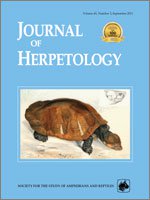Clay models have been used to investigate the relative antipredator effectiveness of cryptic and of aposematic coloration in litter frogs, but such studies do not account for possible differences in prey escape behavior. We examined the escape behaviors of two litter frogs, the cryptic Craugastor bransfordii and the brightly colored and toxic Oophaga pumilio, in response to a human predator. For all individuals, we measured the distance between the frog and the observer at the instant of flight and the distance between frog's initial and final positions in the field. The cryptic C. bransfordii had a shorter flight initiation distance than did nonvocalizing individuals of the brightly colored O. pumilio. In addition, we noted that vocalizing O. pumilio males had a shorter flight initiation distance than did either nonvocalizing male or female O. pumilio. These findings demonstrate that a cryptic and an aposematic litter frog differ in their escape response to a predator. These results also suggest that, at least in male O. pumilio, a trade-off may exist between predator avoidance and reproductive success via territorial defense and mate attraction.
How to translate text using browser tools
1 September 2011
Differences in Escape Behavior between a Cryptic and an Aposematic Litter Frog
L. Deniz Ozel,
Jennifer L. Stynoski
ACCESS THE FULL ARTICLE
<
Previous Article
|

Journal of Herpetology
Vol. 45 • No. 3
September 2011
Vol. 45 • No. 3
September 2011




